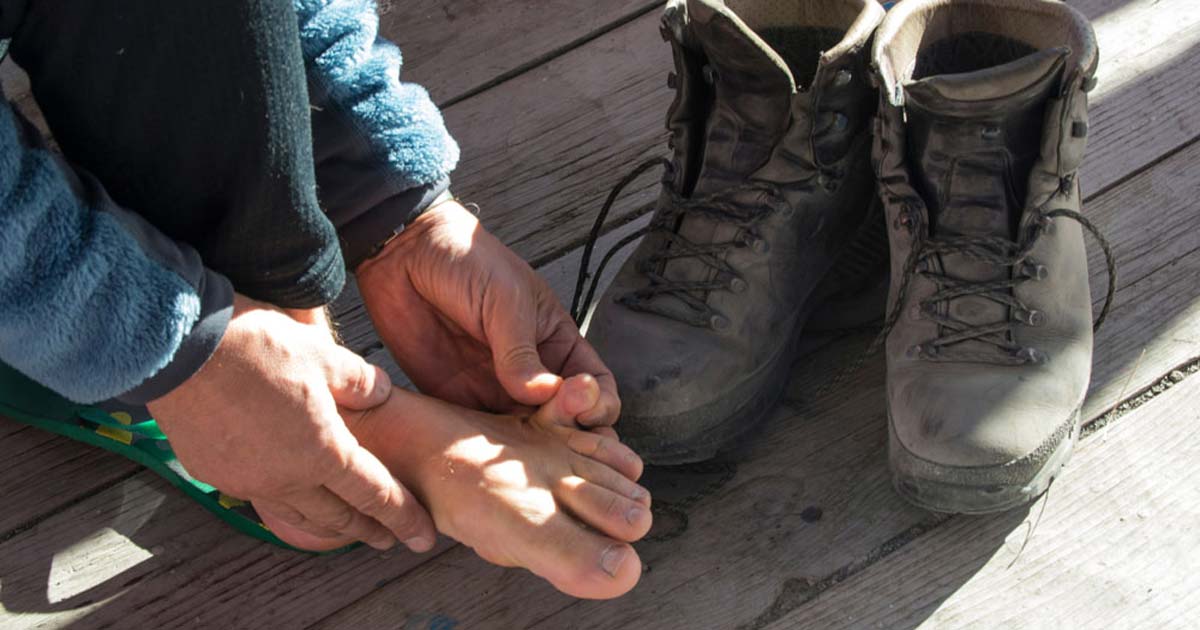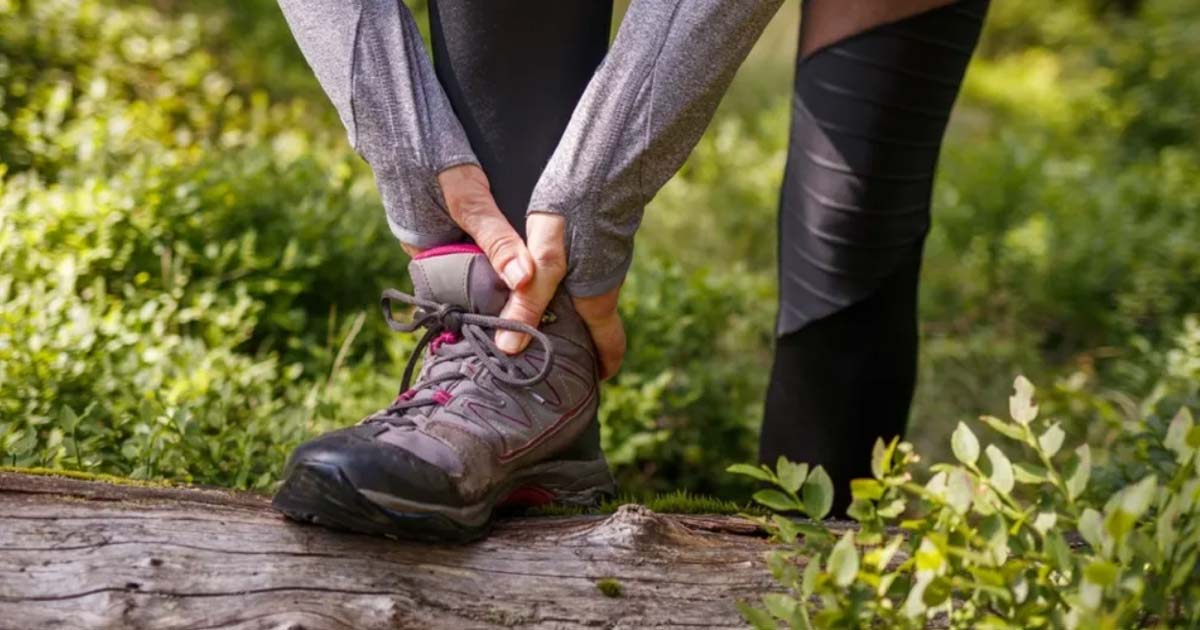Hiking is a great way to enjoy the outdoors and get some exercise, but it can be tough on your feet as this is where you spend most of your time. Sore feet can make the experience less enjoyable and even cut your trip short. Fortunately, there are steps you can take to prevent sore feet when hiking. Here’s a few tips to help prevent sore feet on your next hiking adventure.
Choose the right footwear
The right footwear is essential for preventing sore feet when hiking. You need a pair of shoes or boots that fit well and provide adequate support for your feet and ankles. Look for footwear that is designed for hiking and has a sturdy sole with good traction. You may also want to consider waterproof or breathable materials, depending on the weather and terrain you’ll encounter on your hike.
Break in your footwear
New footwear can be stiff and uncomfortable, so it’s important to break them in before hitting the trails. Wear your shoes or boots around the house or on shorter walks to get them comfortable and mold to your feet. Breaking them in will also help prevent blisters and other foot injuries.
Wear moisture-wicking socks
Moisture-wicking socks are a must when hiking. These socks are designed to pull sweat away from your feet, keeping them dry and reducing the risk of blisters. Avoid cotton socks, which tend to trap moisture and can lead to foot problems.
Use foot powder
Foot powder can help keep your feet dry and prevent blisters. Apply foot powder to your feet before putting on your socks and shoes, paying special attention to areas that are prone to blisters, such as the heels and toes.
Take breaks and stretch
Taking regular breaks and stretching your feet can help prevent soreness and fatigue. Take off your shoes and socks, wiggle your toes, and stretch your calves and ankles. You can also massage your feet to promote blood flow and reduce swelling.
Use hiking poles
Hiking poles can help reduce the strain on your feet and legs while hiking. They provide extra support and help distribute your weight evenly, reducing the impact on your feet. Plus, they can be useful for maintaining balance on uneven terrain.
Plan your route carefully
Finally, plan your route carefully to avoid unnecessary strain on your feet. Choose trails that are appropriate for your fitness level and experience, and consider the terrain and elevation. If you’re not used to hiking, start with shorter hikes and work your way up to more challenging trails.

Medical conditions that can cause foot pain
While there are preventative measures you can take, there are several medical conditions that can cause foot pain. Here are some of the most common medical conditions that can cause foot pain when hiking:
- Plantar Fasciitis: This is a common condition where the plantar fascia, a thick band of tissue that runs along the bottom of the foot, becomes inflamed. It can cause pain in the heel and arch of the foot, especially after periods of rest or activity. Hiking is an activity that can cause the plantar fascia to become inflamed due to its repetitive nature and the added weight of carrying a backpack. If you’re a hiker with faulty foot mechanics (i.e. flat feet) you’re more at risk for developing plantar fasciitis.
- Flat Feet: Flat feet, or fallen arches, can cause pain and discomfort in the feet and legs due to the lack of support for the arches.
- Achilles Tendinitis: This condition occurs when the Achilles tendon, which connects the calf muscle to the heel bone, becomes inflamed and painful.
- Bunions: A bunion is a bony bump that forms on the joint at the base of the big toe. It can cause pain and discomfort, especially when wearing shoes.
- Morton’s Neuroma: This is a condition where a nerve in the ball of the foot becomes inflamed and causes pain, tingling, or numbness in the toes.
- Arthritis: Various forms of arthritis, including osteoarthritis and rheumatoid arthritis, can cause foot pain and stiffness.
- Gout: Gout is a form of arthritis caused by a buildup of uric acid crystals in the joints. It can cause sudden, severe pain in the big toe, ankle, or knee.
- Plantar Warts: These are small, hard growths on the sole of the foot caused by a viral infection. They can be painful, especially when walking or standing.
- Stress fractures: These are small cracks in the bones of the foot, often caused by overuse or repetitive strain.

Relieving sore feet after a hike
Foot pain after a hike is a common occurrence, especially if you have been on a long or strenuous hike. Here are some tips to help relieve foot pain and promote healing:
- Rest your feet: One of the most effective ways to relieve foot pain after a hike is to rest your feet. Elevate your feet and keep them elevated for a while to help reduce swelling.
- Apply ice: Applying ice to your feet can help reduce inflammation and relieve pain. Wrap a cold pack or a bag of ice in a towel and apply it to the affected area for 15-20 minutes at a time, several times a day.
- Take a warm foot bath: A warm foot bath (with epsom salts) can help soothe sore muscles and increase blood flow to the feet. Fill a tub with warm water and soak your feet for 15-20 minutes. You can then transition to a cold bath (or ice pack) for 10 minutes. Repeat two or three times, and be sure to end on cold. This alternating temperature contrast promotes recovery and relieves sore muscles.
- Use a foot roller or massage ball: Using a foot roller or massage ball can help relieve tension in the feet and promote healing. Roll your feet over the ball or roller, applying gentle pressure, for several minutes at a time.
- Wear comfortable shoes: Wearing comfortable, supportive shoes can help relieve foot pain and prevent further injury. Look for shoes with good arch support and cushioning.
- Stretch your feet: Stretching your feet can help relieve tension and improve flexibility. Try exercises like toe curls, ankle circles, and calf stretches to help relieve foot pain.
- Take over-the-counter pain relievers: Over-the-counter pain relievers like ibuprofen or acetaminophen can help relieve foot pain and reduce inflammation.
If you are experiencing persistent or severe foot pain, it’s important to see a doctor or podiatrist for an evaluation, proper diagnosis and treatment or management program. Sore feet can certainly put a damper on your hiking adventure, but there are steps you can take to prevent them if they aren’t medically related. Choosing the right footwear, breaking them in, wearing moisture-wicking socks, using foot powder, taking breaks and stretching, using hiking poles, and planning your route carefully can all help keep your feet happy and healthy on the trails.


